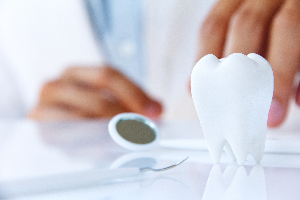
When you think about tooth extraction, you may picture a young patient who needs a baby tooth pulled to make way for his or her adult teeth. However, many dental extractions are actually performed on adult patients with permanent teeth.
In this blog, we discuss what adult patients should know about dental extractions.
Why Do Dentists Remove Permanent Teeth?
Ideally, individuals should be able to keep and use their natural teeth for their entire lives. Natural teeth are the most comfortable and often the best option in almost all cases. Dentists only consider permanent tooth extraction in situations where other dental techniques cannot resolve an issue.
Common reasons for adult tooth extraction include:
- Cracks—Cracks can appear in teeth for a number of reasons. Some cracks are caused by biting down wrong on hard foods, while others result from impact injuries to the head or mouth. If the crack is limited to the chewing surface of the tooth, your dentist may be able to repair it. However, cracks that extend into the root of the tooth usually require extraction.
- Decay—Extensive decay can make a tooth unusable and extremely painful. In some cases, the decay can even affect the teeth on either side of the main tooth or the jaw bone. If the decay cannot be excised in a root canal, you may need a dental extraction instead.
- Infections—If you have a serious infection in the inner section of a tooth or if you are at high risk of infection, tooth removal may be a necessary solution. For example, it’s more common for patients with autoimmune disorders to need their teeth extracted than healthy adults.
- Lack of Support—If a tooth’s root and the gum tissue around it become too compromised, the tooth may become loose on its own. This lack of support usually results from advanced periodontal disease and could require tooth extraction if gum grafts and other surgical efforts are no longer viable options.
- Misalignment—Many individuals consult with dental professionals to try and achieve a straighter, more attractive smile. If you have teeth that are severely misaligned or that are too large or too small for your smile, your orthodontist may remove and replace these teeth as part of your smile transformation.
Unless the tooth is removed for orthodontic purposes, your dentist will likely recommend replacing the natural tooth with an implant or bridge so that your remaining teeth do not shift and fill the gap.
What Does the Extraction Process Entail?
While tooth extraction may seem intimidating, the procedure is actually fairly straightforward. Before the tooth is removed, your dentist will set up an appointment where he or she can closely review X-ray images of the affected tooth and the surrounding teeth, gum tissue, and jaw bone.
If the tooth removal is going to be highly complex, your dentist may refer you to an oral surgeon who has experience with impacted wisdom teeth and other types of difficult adult tooth extractions.
Regardless of who performs the extraction, the process will be much the same. Your dentist will apply a topical anesthetic and then inject the area around the affected tooth with a local anesthetic. This anesthetic procedure is just like the one used before applying a filling or performing a root canal. If you have severe dental anxiety or resistance to the dental anesthetic, your dentist may recommend nitrous oxide, also known as laughing gas, or even general anesthesia which produces unconsciousness during the procedure.
Once you are completely numb, your dentist will loosen and lift the tooth in question using a handheld tool called an elevator. When the tooth is free of most of its support, your dentist will remove it with forceps.
Your dentist will then evaluate the bone and gum tissue in the area to determine if any reshaping or closing is required. Your dentist may close the opening in the gum tissue with one to two stitches.
What Happens After a Permanent Tooth Is Removed?
After an extraction, it’s important to keep the area clean to reduce the risk of infection. Your dentist may place gauze over the opening. Usually, you can remove the gauze after approximately 45 minutes.
You should not do anything to agitate the extraction site for at least 24 hours, including smoking or brushing the teeth on either side. Depending on your health, the opening should heal within a few days to two weeks. Your dentist may recommend that you rinse with salt water or take pain medication to make the healing process easier.
Once the extraction site has healed, you may be able to replace the missing tooth with a bridge or implant.
Before extracting permanent teeth, dentists usually consider all other options, including reparative dental work like crowns. If you have a severely damaged or painful tooth, talk to your dentist about the possibility of tooth extraction and your tooth replacement options after the procedure.
